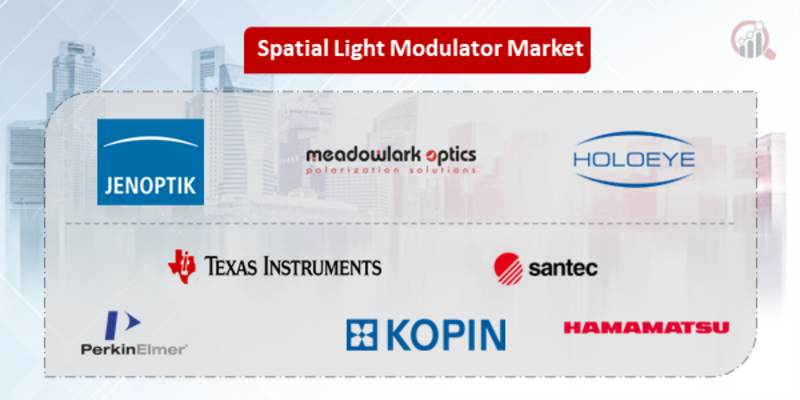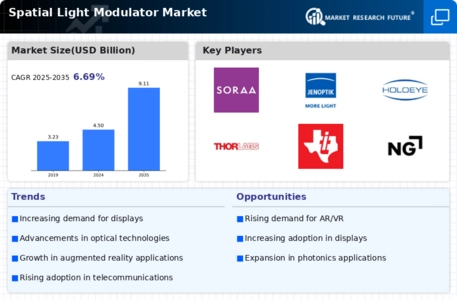Top Industry Leaders in the Spatial Light Modulator Market

*Disclaimer: List of key companies in no particular order
Spatial Light Modulator Market: A Competitive Landscape Analysis
The spatial light modulator (SLM) market stands poised for significant growth, driven by its increasing adoption across various applications, including augmented reality (AR), displays, optical computing, and medical imaging. This burgeoning sector attracts established players and ambitious newcomers alike, creating a dynamic and competitive environment. Understanding the key players, their strategies, and the overall competitive scenario is crucial for navigating this complex landscape.
Some of the Spartial Light Modular companies listed below:
- Jenoptik AG
- Meadowlark Optics Inc.
- Holoeye Photonics AG
- PerkinElmer Inc.
- Texas Instruments, Inc.
- Kopin Corporation
- Santec Corporation
- Hamamatsu Photonics K.K.
- Laser 2000 Ltd.
- Thorlabs, Inc.
Strategies Adopted by Key Players:
- Focus on Technological Advancements: Companies are continuously investing in research and development to develop SLMs with higher resolution, faster response times, and improved efficiency. This focus on technological advancements aims to meet the evolving demands of emerging applications.
- Application-Specific Solutions: Companies are strategically developing SLMs tailored to specific applications, such as AR displays, medical imaging systems, and optical tweezers. This approach enables them to cater to the unique needs and requirements of various market segments.
- Collaborations and Partnerships: Strategic collaborations and partnerships are crucial for accelerating innovation, sharing expertise, and expanding market reach. Companies collaborate with research institutions, universities, and industry partners to leverage complementary strengths and resources.
Factors Influencing Market Share:
- Technology Leadership: Companies offering SLMs with superior performance characteristics, such as high resolution, fast response times, and improved efficiency, will gain a significant market share advantage.
- Cost-Effectiveness and Scalability: Offering cost-effective solutions and ensuring scalability of production processes are crucial for widespread adoption, particularly in price-sensitive markets.
- Application Focus and Customization: Companies catering to specific applications and offering customization options to meet diverse user requirements will attract customers seeking tailored solutions.
- Compliance with Regulations: Adherence to evolving regulations and standards regarding safety, environmental impact, and data privacy is essential for smooth operation and legal compliance.
New and Emerging Companies:
Several new and emerging companies are actively disrupting the SLM market with innovative approaches and technologies, including:
Lightmatter: Pioneering the use of metamaterials for SLMs, enabling faster modulation speeds and improved light-manipulation capabilities.
SiFive: Developing RISC-V based chipsets for SLMs, promising lower power consumption and increased processing efficiency.
Airspan Networks: Focusing on open-source, software-defined SLM solutions aimed at creating more flexible and cost-effective infrastructure.
Latest Company Updates:
On Jul. 04, 2023- Hamamatsu Photonics, a leading optical technology company, announced the development of a ground-breaking LCOS-SLM (Liquid Crystal on Silicon - Spatial Light Modulator), the X15213-03CL. The system was developed using its innovative thermal design technology to enhance heat dissipation performance. The new LCOS-SLM X15213-03CL has an unparalleled power handling capability of up to 700 W and streamlines laser metal machining production with unmatched light resistance.
On May 02, 2023- Meadowlark Optics announced the acquisition of Boulder Nonlinear Systems (BNS). Based in Colorado, both companies produce optical component used in various scientific research fields and industries. The acquisition will enable Meadowlark to develop additional products expanding upon the spatial light modulators and liquid crystal polarization products, including switchable gratings.
Meadowlark manufactures polarization solution components, including liquid crystal shutters, rotators, and spatial light modulators for the UV and MWIR wavelengths. It has previously purchased the commercial Spatial Light Modulator business from BNS in 2014.
On Nov. 30, 2022- MIT researchers announced the development of a spatial light modulator (SLM) that enables optical control at unprecedented speeds. The new programmable device promises greater light control at magnitude orders faster than commercial devices.
The team has also developed a fabrication process that ensures consistent device quality when manufactured at scale. This spatial light modulator can be used to create superfast lidar sensors for self-driving vehicles, creating images about a million times faster than existing mechanical systems. It can also be used to accelerate brain scanners that use light to see through tissue.
